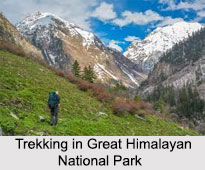 Nestled amidst the snow-capped Himalayas, the Great Himalayan National Park is located at an altitude of 1500-6000 metres and is situated in the Seraj tehsil of Kullu district. It was built in 1984 and was declared as a National Park in 1999. From lush green forests to blooming flowers and meandering streams, this place also houses various well laid out trek paths.
Nestled amidst the snow-capped Himalayas, the Great Himalayan National Park is located at an altitude of 1500-6000 metres and is situated in the Seraj tehsil of Kullu district. It was built in 1984 and was declared as a National Park in 1999. From lush green forests to blooming flowers and meandering streams, this place also houses various well laid out trek paths.
Park Treks in Great Himalayan National Park
There are few moderate to difficult trekking routes in this park. They are the Sainj valley, Gushaini to Parvati valley and Sainj to six other meadows. Depending on the level of difficulty, travellers have the option to camp for how much long they wish.
Flora and Fauna of the Great Himalayan National Park
Due to the multifaceted topography and enormous variations in altitude, the area of the Park encompasses a huge range of species from the subtropical to the alpine and includes traits of Asian forests as well as those found in Siberia and the higher steppes. Only a very few national parks offer such a vast range of biological diversity. Featuring primarily deodar and oak trees, the Great Himalayan National Park showcases more than 100 plant species, including medicinal herbs. The list is long and varied from pine, chestnut, and spruces to junipers and alpine herbs. Even in lower altitudes, there are some alpine meadows exhibiting full variety of flowers and colourful shrubs, cleared for grazing.
Birds of the park are major attraction. More than 181 species of birds are seen here. Feathery creatures which reside in the park are the kokalass pheasant, cheer pheasant, lammergeiers, Himalayan griffon vultures, golden eagles, snow cock and a large array of other birds. Among the larger mammals that one may encounter are; goral, Himalayan tahr, bharal, blue sheep, Himalayan black bear, Asiatic brown bear, leopards and snow leopard. There are immense options available for trekking. And all travellers must look to avail the best possible option for the same. The best sighting is experienced from September to November when animals migrate to the lower grounds.
Visiting Information on Trekking in the Great Himalayan National Park
Entrance to the Great Himalayan National Park is strictly by permit. The best time to visit the Park is from March to June and from mid September to November. Winter months are not advisable for visit due to extremely cold and chilly weather and snowfall.
The nearest railway station is at Pathankot, from there it is a 5 hours long drive to Aut. By roadways, the shortest route to Aut goes through Chandigarh, Bilaspur, Mandi, and then Banjar or Sainj, the two main entries to the Park. One can also come from Shimla by the Jalori pass, but the pass is closed during winters because of snow.




